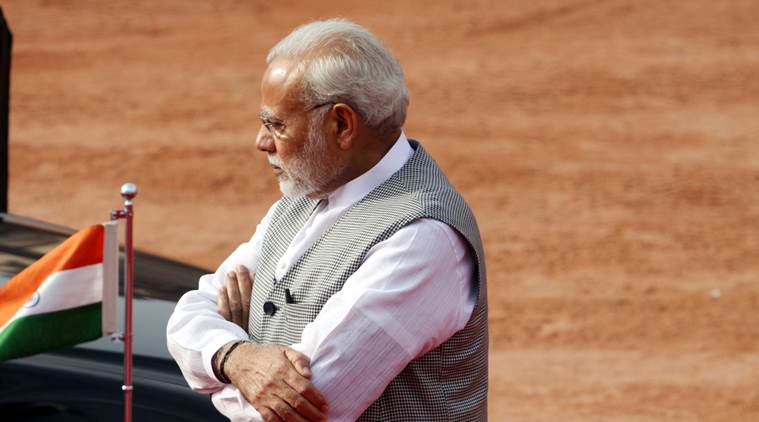Raja Mandala: Falling behind on Digital Silk Road
India has the chance to foster connectivity and strategic cooperation across Asia. Here, too, China seems to be racing ahead.

Prime Minister Narendra Modi. (Express file photo/Praveen Jain)
India’s continuing political challenges with China’s Belt and Road Initiative have been matched by Delhi’s enduring difficulties in advancing its own connectivity initiatives. Consider, for example, Prime Minister Narendra Modi’s two recent high-level engagements — in Qingdao, China earlier this month and his engagements with the Southeast Asian leaders in late May.
At the Qingdao summit of the Shanghai Cooperation Organisation, where India was participating for the first time as a full member, Delhi had to dissociate itself from the consensus in favour of President Xi Jinping’s Belt and Road Initiative (BRI). In Jakarta, the PM unveiled his ambitions to strengthen maritime connectivity with Indonesia, including the development of port infrastructure in the Sumatra Island. But there is no denying the gap between Delhi’s promise and performance on connectivity.
Meanwhile, China’s BRI will inch closer towards India this week when Nepal Prime Minister Khadga Prasad Sharma Oli travels to China. Like most other neighbours of India, Nepal has already endorsed President Xi’s Initiative. But like Pakistan, Sri Lanka and the Maldives, Nepal is getting ready to sign onto major BRI projects. Many of these projects would be grouped under the so-called Trans-Himalayan Connectivity Initiative. This is likely to include oil storage terminals, rail and road links, hydel projects and electricity transmission lines.
Although the question of costs relating to China’s projects has been raised in many parts of the world, including most recently in Malaysia, it is unlikely to dampen the enthusiasm for the BRI among India’s neighbours. For them, the issues relating to these projects are as much economic as they are political.
For Pakistan, the participation in China’s BRI is very much part of its ever-deepening strategic partnership that was forged decades ago to balance India. For other neighbours, the BRI offers, shall we say, “strategic autonomy” from India.
If Delhi had taken for granted the deep geographic interdependence with its neighbours and did little to modernise it for the 21st century, our neighbours had no choice but to swallow it. Now they have an alternative, expensive though it might be, in the form of Chinese connectivity initiatives. They are embracing BRI without any hesitation.
The idea of seeking strategic autonomy from very large neighbours is not unique to South Asia. Many of China’s immediate neighbours in East Asia do much the same — they seek insurance through diversifying partnerships with many countries, including India. But unlike China, India has not been able to deliver on the promises it has made to its East Asian partners.
If India has found it hard to develop institutional capabilities to implement infrastructure projects across and beyond its borders, it has some possibilities in the arena of digital connectivity. They were demonstrated during PM’s visit to Singapore where he signed a number of agreements to connect the financial markets of the two countries. These included the launch of India’s RuPay card, the BHIM QR code and SBI’s cross-border remittance app. Last year, India had launched the South Asia Satellite as part of its neighbourhood first policy.
But here again, China is racing ahead. Beijing has launched a number of ambitious initiatives, now being banded together as the “Digital Silk Road”. China’s Digital Silk Road agenda is about strengthening internet infrastructure, deepening space cooperation, lowering barriers to e-commerce, developing common technology standards, promoting cyber security, and improving the efficiency of policing systems among the BRI countries. China wants to deploy its nationally developed platforms based on artificial intelligence, big data, cloud storage and quantum computing to pursue these goals.
China and Nepal, for example, have operationalised an optic fibre link between the two countries earlier this year. The link would eventually reduce Nepal’s dependence on India for internet connectivity. Last year, China’s Huawei signed an agreement to construct the Pakistan East Africa Cable Express (PEACE) that would connect Pakistan to Kenya via Djibouti. Huawei may extend this cable to Egypt in the north and South Africa. When completed, the cable is likely to have a total length of 13,000 km.
China’s digital initiative also includes deepening space cooperation. Besides its long-standing space cooperation with Pakistan, China is discussing plans to launch a national satellite for Nepal. Last year, Sri Lanka joined China’s Beidou navigation system. China wants to leverage its earth observation satellite capabilities to deepen cooperation in a number of areas ranging from environmental monitoring to disaster management. Oli’s visit to Beijing is expected to see the signing of a bilateral agreement on setting up disaster management centres in Nepal that will be linked to China’s national remote sensing system.
India has long had significant and growing national capabilities in the digital and space domains. But Delhi has fallen terribly short in integrating these with larger national economic and security strategies. Delhi’s bureaucratic bias towards to over-regulation, restrictions on the domestic private sector, constraints on innovation and suspicion of external collaboration have limited India’s possibilities on digital development and diplomacy.
At the turn of the century, India paid little attention to China’s internal, cross-border and international infrastructure projects that eventually came under the rubric of BRI. As a result, Delhi is struggling to cope with the strategic consequences for the Subcontinent and the Indian Ocean. Unless Delhi quickly sheds its digital defensiveness, that pattern might well repeat itself with China’s newest version of the Silk Road.
The writer is director, Institute of South Asian Studies, National University of Singapore and contributing editor on international affairs for The Indian Express
For all the latest Opinion News, download Indian Express App
More From C. Raja Mohan
- Donald Trump meets Kim Jong-un: Together, preparing to disrupt the Asian orderWorking together with South Korean President Moon Jae-in, Donald Trump and Kim Jong-un are getting ready to turn Asian geopolitics inside out...
- Reading the Singapore Summit statement: Three principles and one political gestureIn the course of one morning in Singapore, US President Donald Trump and the North Korean leader Kim Jong-un have begun to loosen a deeply…
- Donald Trump-Kim Jong meet: Suspense in SingaporeGiven the history and personalities involved, it is difficult to be overly hopeful about Trump’s meeting with Kim Jong-un today. But a breakthrough could change…







































No hay comentarios:
Publicar un comentario